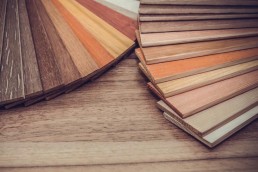There are various components in staircases such as handrails, balusters, newels, risers, stringers, and treads. Treads, are the part of the staircase you physically step on and are commonly referred to as a step. Treads can be made from a variety of different materials depending on the preferences of the user. Treads are usually the largest surface on a custom staircase, which implies the material I choose will contribute heavily to the overall look of the custom staircase itself.
Stair Tread Materials
Stair tread options include wood, steel, stone, and glass. If I choose wood, some of the more common choices include Red Oak, White Oak, Maple, Cherry, Mahogany, Hickory, or walnut. However, there are also many additional wood species that are more exotic. This choice is typically determined by the hardwood flooring I choose as the treads are often seen as simply an extension of the floor. On the other hand, if I decide to go with Steel Treads, there are a variety of products such as Smooth Plate, Pre-Drilled Smooth Plate, Diamond Plate, Perforated Plate or Textured Metal. Steel can be finished in a variety of painted, powder-coated, or patina finishes. If I want my project to be fitted with Stone or Glass treads, there is also many varieties which include Laminated Glass Treads in various patterns and colors, and various Stone, Granite, Ceramic Tile or pre-cast concrete. The options are truly endless, especially in Salt Lake City.
Budget-Friendly Materials
When choosing the type of tread I want to be fitted in my project, I may prefer to choose one that is more budget-friendly. For instance, Red Oak Stair Treads and Maple Stair Treads are quite common, very affordable and durable. Another relatively affordable wood species is the Hickory Stair Tread. These treads, while more economical, are very durable and will last a lifetime.
 Now once I’ve decided on the type of stair tread, another choice that I have to make is how I intend to finish the treads. If I chose a glass or steel tread then I’m typically not as concerned with it matching the surrounding floors. However if I’ve decided on a wood tread then the stain and finish I choose will typically be the same for the hardwood floors. Natural finishes will highlight the natural grain and various tones in the wood. Medium finishes can add depth and richness to the wood. While darker finishes can even out those various natural tones typical to wood and create uniformity while still allowing for its unique grain pattern. This latter option is popular in more contemporary designs.
Now once I’ve decided on the type of stair tread, another choice that I have to make is how I intend to finish the treads. If I chose a glass or steel tread then I’m typically not as concerned with it matching the surrounding floors. However if I’ve decided on a wood tread then the stain and finish I choose will typically be the same for the hardwood floors. Natural finishes will highlight the natural grain and various tones in the wood. Medium finishes can add depth and richness to the wood. While darker finishes can even out those various natural tones typical to wood and create uniformity while still allowing for its unique grain pattern. This latter option is popular in more contemporary designs.
Make Sure They Are Installed Correctly
One last thing. Treads should not in any way creak, squeak, or make cracking noises. Unfortunately this is one of the more common complaints people have with stairs. On the contrary, they should be solid, quiet, and durable enough to last a lifetime. There are very specific tricks of the trade to ensure this and is just one more reason to hire a professional Stair Contractor who’s licensed, insured and has the experience to walk through the myriad of choices available today.

